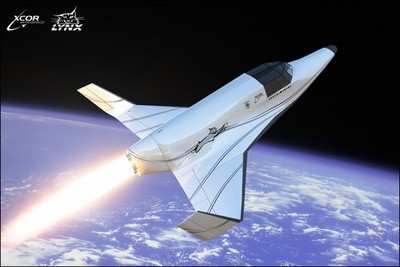Lynx Spacecraft Will Help Investigate Upper Atmosphere, Edge Of
Space
NASA has selected XCOR Aerospace to provide suborbital flight
and payload integration services for research and scientific
missions in a program that will offer up to $10 million dollars in
contracts to match payload customers with flight vehicle services.
The awards were announced by NASA's Flight Opportunities Program, a
part of NASA's Office of the Chief Technologist at NASA
Headquarters in Washington, DC that is managed at Dryden Flight
Research Center in Edwards, California.

"Through this award, NASA has recognized XCOR's Lynx suborbital
vehicle as a useful payload platform that will benefit both NASA's
R&D needs and the private research, scientific, and educational
communities," said Jeff Greason, XCOR CEO. "By encouraging
and incentivizing frequent, low cost access to space, NASA is
helping to ensure America's future as a leader in space."
XCOR's suborbital reusable launch vehicle, Lynx, is capable of
up to four flights per day using advanced rapid call-up and
turnaround operations. The Lynx will provide three to four minutes
of microgravity as well as, if desired, exposure to a space
environment. This will provide opportunities to investigate the
largely unexplored regions of our upper atmosphere.
XCOR has partnered with four leading payload integration
providers in the US to give NASA and the research community a
first-rate experience for the Program's missions. The Planetary
Science Institute (PSI) of Arizona, Southwest Research Institute
(SwRI) in Texas, NanoRacks LLC of Kentucky and Washington, DC, and
Spaceflight Services of Washington will provide payload processing
and related support services based on their multiple areas of
expertise. These independent payload service providers
specialize in atmospheric science, physics, microgravity research,
planetary science, Earth observation, and life sciences, and other
areas. XCOR's partners are among the premier organizations in
specialized suborbital and orbital commercial payload development
and integration. PSI recently announced their Atsa Suborbital
Observatory, a versatile facility that will maintain cameras and
telescopes to conduct astronomical observations or remote sensing
of the Earth, will fly on Lynx. SwRI is the pioneering national
research institute that will be the first Lynx launch customer for
broad based suborbital payload integration and research. NanoRacks
and Space Flight Services are national leaders in orbital payload
integration and science experimentation, with NanoRacks already
providing research platforms on the International Space Station and
SpaceFlight Services offering stand alone on-orbit research and
transport of experiments to the ISS in the SpaceX Dragon
capsule.

"We're building our Lynx suborbital vehicle to accommodate as
many of these missions as possible," remarked XCOR's COO Andrew
Nelson. "By integrating multiple payload spaces both inside the
pressurized cabin and exposed to the vacuum of space we can handle
a large variety of experiments as well as the researchers
themselves. This is currently a very underserved market, with long
lead times and no guarantee of payload recovery on conventional
sounding rockets. NASA is jump-starting a revolution in the
commercial space industry and scientific research by pairing up
payload investigators with cutting edge private suborbital vehicle
providers such as XCOR."
 ANN's Daily Aero-Linx (05.02.24)
ANN's Daily Aero-Linx (05.02.24) ANN's Daily Aero-Term (05.02.24): Touchdown Zone Lighting
ANN's Daily Aero-Term (05.02.24): Touchdown Zone Lighting Aero-News: Quote of the Day (05.02.24)
Aero-News: Quote of the Day (05.02.24) ANN FAQ: Contributing To Aero-TV
ANN FAQ: Contributing To Aero-TV NTSB Final Report: Cirrus Design Corp SR20
NTSB Final Report: Cirrus Design Corp SR20




